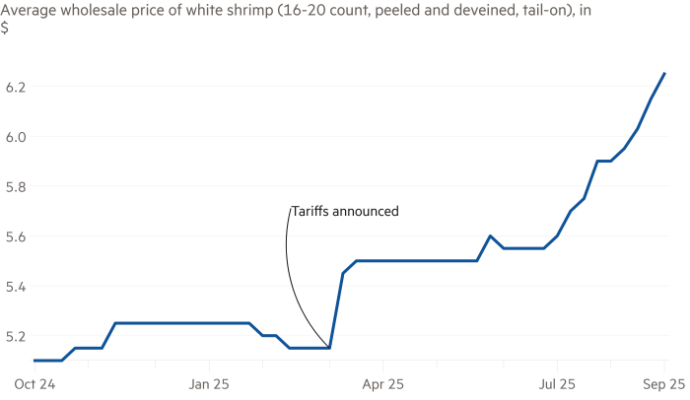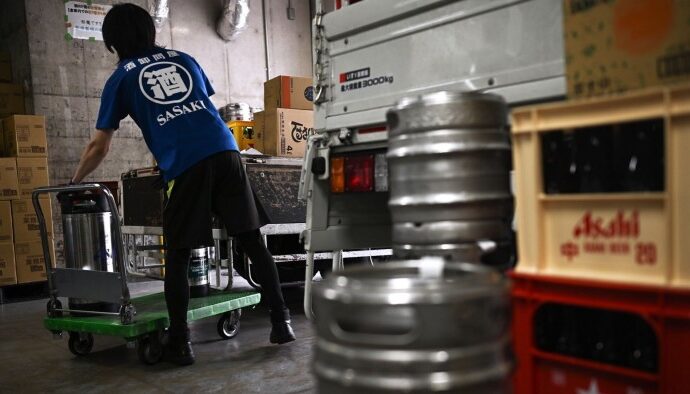If I were an Australian wine producer, I’d be extremely frustrated. On the basis of the many current Australian wines I get to taste, I know that the quality and diversity of Australian wine has never been greater, but the rest of the world pretty much ignores it.
There is one big exception to this: China. China imposed crippling import tariffs on Australian wine in November 2020 (when it was Australian wine’s most important export market by far) and lifted them at the end of March 2024 so that resumed exports of premium Australian red wine to China represented the one bright spot in Wine Australia’s report on exports for the 12 months to March 2025.
The average value of a litre of bottled Australian wine shipped to the UK in the year to March 2025 was just A$5.54, to the US an even lower A$4.65. But the Chinese equivalent was A$23. This meant that 39 per cent of the value of Australian wine exports was in exports to one country, China, which is surely dangerous. What if some Australian politician badmouths the Chinese government again? Australian wine exporters could be back to square one.
We Brits have long been Australian wine’s biggest export market by volume, and we still are, importing almost twice as much as the US, the second biggest. But both the UK and US declined quite substantially in both volume and value in the year to March, as did all other major export markets except for a slight increase in the value of shipments to Canada.
If I were an Australian vigneron, I’d be especially frustrated by the lack of interest shown by the world’s biggest wine market, the US. Last year Americans spent more than twice as much in total on wine from tiny New Zealand than on Australian wine, which they still seem to see as irredeemably cheap — and not in a good way.
If only a few influential Americans could have joined me in the delightfully cool, spacious crypt of St James’s Church in Clerkenwell at the end of April this year to taste a selection of the 184 Australian wines imported into the UK on show. It would surely have changed a few minds.
I scored more than 20 of the 60-plus I managed to taste at least 17 out of 20, a high mark for me. And none of them had the sort of three-digit prices that have become so common for French wines.
There were a couple of real bargains from biodynamic pioneer M Chapoutier of the northern Rhône, whose Australian operation Tournon is in the state of Victoria. They were unusually mature too, as though they’d been forgotten in a warehouse somewhere. The Mathilda 2022 blend of white Rhône grapes Viognier and Marsanne is only 13 per cent alcohol and drinking beautifully now, while the 2017 Shays Flat Shiraz nicely applies French polish to the Syrah of the northern Rhône grown in a relatively cool part of Victoria.
It’s no surprise that four of my favourite reds were Shiraz/Syrah, Australia’s most-planted grape. (Australians tend to use Syrah on labels to signify determinedly lighter versions.) What was surprising, given the country’s reputation for big, bold wines, was that five of my favourite reds were based on the delicate Pinot Noir grape of Burgundy: one each from the relatively cool Adelaide Hills and Tasmania and three from Victoria. This would surely impress a sceptical American.
Unusually nowadays, this was a tasting with only one wine sold as a rosé. But the Murdoch Hill Pinot Noir 2023 from Adelaide Hills was so delicately floral, it was a rosé manqué — not for keeping perhaps, but a delight. It contrasted dramatically with the Tasmanian Tolpuddle Pinot Noir 2023 that is very much made for keeping, and has developed quite a reputation in Australia in a relatively short time. None of the Victorian Pinots was a bargain, and Bass Phillip has earned such réclame over the years that even its least expensive bottling, the subtle, earthy Estate Pinot 2021, commands a high price.
Nick Farr, son of the founder of Bannockburn, another fine Pinot producer on the Victorian coast, makes Irrewarra Pinot based on a vineyard well inland from Bannockburn in Geelong. Vines were planted back in 2001 by John and Bronwynne Calvert, who run a renowned sourdough bakery in the town of Irrewarra. Irresistible, surely?
Gembrook Hill Pinot Noir 2023 meanwhile showed how well-suited the Yarra Valley outside Melbourne is to the grape, as do the many single-vineyard bottlings from Giant Steps.
Of the two Clonakilla Shirazes shown in the crypt, I thought the less expensive Hilltops 2022 made from bought-in fruit was better value than the estate-grown 2023.
Another recent London tasting was devoted to Australia’s best Grenaches, of which there are many, so I skipped those shown in the crypt — although I recommended an array of these juicy reds in my May 17 article.
Of the other white wines I tasted, one really stood out. MMAD Vineyard in fashionable McLaren Vale south of Adelaide was founded by the team behind Shaw + Smith in Adelaide Hills. It’s devoted mainly to Shiraz and Grenache but the most unusual wine was a 2023 dry white Chenin Blanc based on vines planted in 1964 and only 12.5 per cent alcohol. I’d love to taste it alongside a fine South African counterpart.
Vintners in the Hunter Valley north of Sydney were way ahead of today’s enthusiasm for lower-alcohol wines when they established long-lived, lanolin-scented, dry white Sémillon as one of Australia’s unique gifts to the wine world. Tyrrell’s is the leading producer, and its seven-year-old Winemaker’s Selection Vat 1 2018 with only 12 per cent alcohol is drinking beautifully now.
Margaret River on the other side of this vast country is famous for its blends of Sémillon with Sauvignon Blanc and none is more admired than the Grace Madeline blend from biodynamic Cullen. I much preferred the lively 2023 shown in the crypt to the 2022 tasted earlier. Another obvious star was a really distinctive, lightly herbal blend of 2023 white Rhône grapes Roussanne and Grenache Blanc from Thistledown, the admirable project of a Master of Wine based in Scotland.
And then of course there was my beloved Riesling. Australia has a long tradition of producing surprisingly racy, refreshing dry Rieslings, especially from the Clare and Eden Valleys in South Australia. Jeffrey Grosset is the Australian king of Riesling and his Polish Hill bottling is a markedly long-lived classic. The 2012 was in great shape when tasted last year. The latest vintage, 2024, was shown in the crypt but isn’t nearly ready.
But I really liked, for current drinking, another Clare Valley Riesling, the 2023 from Ministry of Clouds, a winery based in McLaren Vale, on the other side of Adelaide. It nicely illustrates the Australian propensity to search far afield for suitable grapes. The most famous Australian wine producer Penfolds, owned by the giant Treasury Wine Estates, which recently issued a profit warning, makes extremely concentrated reds blended from vineyards all over South Australia. It is the sort of wine with which Australia was long associated. The world’s wine lovers need to realise there is another side to contemporary Australian wine, with fresher, arguably more approachable wines in almost infinite variety.
Jancis recommends . . .
Whites
Tournon, Mathilda Viognier/Marsanne 2022 Victoria (13%)
£14.59 All About WineThistledown Wines, Walking with Kings Roussanne/Grenache Blanc 2023 South Australia (13%)
£26.95 NY WinesMMAD Vineyard, Blewitt Springs Chenin Blanc 2023 McLaren Vale (12.5%)
£30 Hic!Cullen, Grace Madeline Sauvignon Blanc/Sémillon 2023 Margaret River (13.5%)
£32.98 Alexander HadleighGrosset, Polish Hill Riesling 2024 Clare Valley (12.1%)
£39 London End, £39.95 Hennings, £47 Berry Bros & RuddTyrrell’s, Winemaker’s Selection Vat 1 2018 Hunter Valley (12%)
£49 VINVM, £53 Hedonism, £54.25 NY Wines, £57 Australian Wines Online
Reds
Tournon, Shays Flat Shiraz 2017 Pyrenees (14.5%)
£18.99 All About Wine, £25.50 TannersClonakilla, Hilltops Shiraz 2022 ACT Canberra (13.5%)
£24 London End, £25.45 VINVM, £28 Shelved WineMMAD Vineyard, Blewitt Springs Shiraz 2022 McLaren Vale (13.5%)
£36 London End, £40 Shelved Wine, £44.50, NY Wines £48.75Thistledown Wines, Where Eagles Dare Shiraz 2021 Eden Valley (14%)
£38.95 Lekker Wines, £46 House of Decant, 48.75Irrewarra Pinot Noir 2022 Victoria (13.5%)
£49 Hedonism. The 2021 is £35.59 Vinified Wine, £39 London EndGembrook Hill Pinot Noir 2023 Yarra Valley (13%)
£49.50 Parched WineGiant Steps, Applejack Vineyard Pinot Noir 2022 Yarra Valley (13%)
£49.70 VINVMTolpuddle Vineyard, Coal River Valley Pinot Noir 2023 Tasmania (13.5%)
£63 92 or More, £66 Tim Syrad Wines, £67.25 Parched WineBass Phillip, Estate Pinot Noir 2021 Gippsland (14%)
£72 Baron Wines, £80.72 Bordeaux Index, £94.95 Brunswick Fine Wines & Spirits
Tasting notes, scores and suggested drinking dates on Purple Pages of JancisRobinson.com. International stockists on Wine-searcher.com. UK importer Justerini & Brooks. US importers various
An introduction to Australia’s classic wines
Western Australia
Margaret River is famous for its Cabernet Sauvignon but also makes fine Chardonnay, Sémillon/Sauvignon Blanc blends and increasingly refined Shiraz. Great Southern is good at Riesling and Shiraz.
South Australia
Known as “the wine state”. Clare Valley is famous for sleek, mainly bone-dry, Riesling. Barossa Valley is the home of rich, concentrated Shiraz, often from very old vines. Eden Valley is cooler than Barossa and makes fine Riesling and Shiraz. Adelaide Hills can be quite cool and is good for Chardonnay and a range of “alternative varieties” (to the famous international ones). McLaren Vale is best at Shiraz and Grenache. Coonawarra is famous for its Cabernet.
Victoria
Victoria is cooler than anywhere other than Tasmania. This means it can make particularly good Pinot Noir and Chardonnay, notably in Yarra Valley and Mornington Peninsula. Heathcote has a reputation for Shiraz.
New South Wales
The most famous wine region is Hunter Valley, where Sémillon and Shiraz rule.
Tasmania
Cool enough to grow base wine for fizz as well as still Pinot Noir and Chardonnay.
Jancis Robinson will be speaking at the FT Weekend Festival on September 6 at Kenwood House Gardens, London. For passes go to: ft.com/festival


